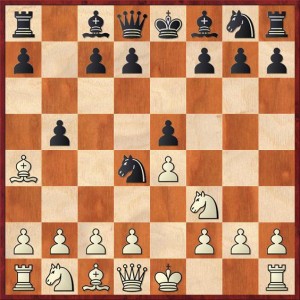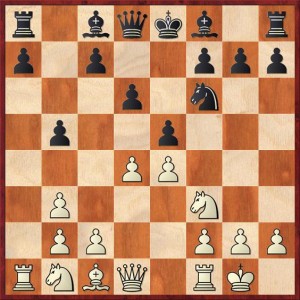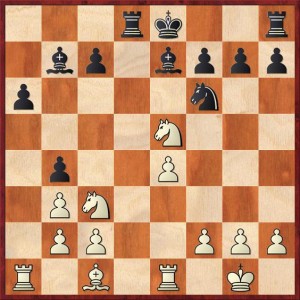 No, not that kind of bird! (That’s a scrub jay who has taken up residence in one of our bushes, driving Max the cat wild.) I mean this kind of Bird:
No, not that kind of bird! (That’s a scrub jay who has taken up residence in one of our bushes, driving Max the cat wild.) I mean this kind of Bird:
 Position after 4. … b5. White to move.
Position after 4. … b5. White to move.
FEN: r1bqkbnr/p1pp1ppp/8/1p2p3/B2nP3/5N2/PPPP1PPP/RNBQK2R w KQkq – 0 5
Here’s the story. Mike Splane was playing his usual weekly game at the Kolty Chess Club last week, and for the first time he found himself facing the Bird Variation of the Ruy Lopez, 1. e4 e5 2. Nf3 Nc6 3. Bb6 Nd4. As a dutiful reader of my blog, he remembered that I had written that the bishop retreat 4. Ba4 had caused me the most trouble as Black. I’m not sure that I actually put it that way, but I have noticed that the strongest players I’ve faced have tended not to play the “automatic capture” 4. Nxd4 but instead play one of the retreats 4. Ba4 or 4. Bc4 (which I call the Bashful Bishop Variations).
So Mike played 4. Ba4, and he was wondering what would happen if Black continued with 4. … b5, leading to the diagram above. In the tournament game, Black didn’t. Mike’s opponent played 4. … Nxf3 5. Qxf3 Nf6 and got a reasonably good position; the game ended up being decided by mistakes later on. I normally play 5. … Qf6. My thinking is that Black, being a tempo behind in development, would be thrilled if White traded queens and gave Black a free tempo to develop his knight. Normally White plays 5. Qg3, and I play 5. … Bc5 (Rybka suggests the crazy-looking 5. … Bd6!?) and we go from there.
I’ve never played 4. … b5, and I don’t think I even talked about it in my “Bird by Bird” series. Certainly it seems like a very direct attempt to punish White for his bashfulness. A good punch in the snout will cure you!
Is 4. … b5 really good? First, I’ve never played it because I didn’t like the looks of 5. Nxd4 ba 6. Nf3, when the pawn at a4 looks hard to defend. I lost a position similar to this against Melikset Khachiyan last year, a game he lectured on at chess.com. In Chessbase the position above has been reached only once in a game between grandmasters: Krum Georgiev (Bulgaria) versus Jonny Hector (Sweden) from the 1989 Olympiad. Mike found this game online and thought it was very instructive, and I tend to agree.
Georgiev didn’t play 5. Nxd4, he played 5. Bb3 instead. And already Hector made a mistake that got him in a lot of hot water. He played 5. … Nxb3?
How can this be a mistake? After all, wasn’t the whole point of 3. … Nd4 and 4. … b5 to “win” the bishop for a knight? You’ll see the answer in a bit, but for now I’ll mention the move that Rybka says Black ought to play: 5. … Bc5! This is a very swashbuckling move, offering a pawn sacrifice for a blitzkrieg attack with 6. Nxe5? Qg5! threatening … Qxg2 and carnage on the kingside. This is very much the sort of variation that would have attracted Henry Edward Bird in the nineteenth century. Instead White should play more conservatively with 6. O-O, and then Rybka recommends 6. … Nxf3. That’s right, the real objective of … Nd4 was to trade knights, not to trade the knight for the bishop!
Now, what’s wrong with Hector’s 5. … Nxb3? Let’s continue a few more moves: Georgiev of course played 6. ab Nf6 7. O-O d6 8. d4 (diagram two).
 Position after 8. d4. Black to move.
Position after 8. d4. Black to move.
FEN: r1bqkb1r/p1p2ppp/3p1n2/1p2p3/3PP3/1P3N2/1PP2PPP/RNBQ1RK1 b kq – 0 8
“What I found impressive about this game was that White just played simple, natural moves, and Black was already in deep trouble,” Mike said. Black is behind in development and has weaknesses all over the place (b5, c6, e5, the a-file). Besides this, the move 5. … Nxb3 was at odds with Black’s fundamental strategic goal in the Bird, which is to prevent or slow down White’s d2-d4 break. I emphasized this over and over in my “Bird by Bird” series, and this game is a great example of what happens when Black doesn’t follow my advice. Notice that the line with … Bc5 and … Nxf3, given above, is consistent with the goal of controlling d4 as much as possible.
From the above position, Hector played 8. … Bb7 9. Re1 and now we see what Black’s problem is. The capture 9. … Nxe4? runs into 10. Qd3!, which not only threatens to win material on e4, it also threatens Qxb5+. And notice that the latter move doesn’t just win a pawn, it wins a whole piece because of the fork. So Black can’t take on e4. Instead, Hector played 9. … a6, reinforcing his weak pawn on b5. When you make weaknesses, then you have to defend those weaknesses, and that gives your opponent extra time to make new threats. It’s a downward death spiral.
Georgiev continued in very straightforward fashion with 10. Nc3 Be7 11. de de 12. Qxd8+ Rxd8 13. Nxe5 b4 (diagram three).
 Position after 13. … b4. White to move.
Position after 13. … b4. White to move.
FEN: 3rk2r/1bp1bppp/p4n2/4N3/1p2P3/1PN5/1PP2PPP/R1B1R1K1 w k – 0 14
With his last move Black recovers the pawn, but he still has a miserable game. Here Rybka thinks that Georgiev actually made a slight mistake. Georgiev gave back the pawn with 14. Nd5 Nxd5 15. ed Rxd5 16. Bf4, leading to a half-pawn advantage according to Rybka. Instead, 14. Na4 Nxe4 15. f3 Nf6 16. Nd3 gives White a full-pawn advantage. Black’s king is stuck in the center, and White is going to plant a knight on c5, where it will eye both b7 and a6.
We’ll let the computer and the grandmaster fight it out over these details. For our purposes, the main messages are these.
- Weaknesses are contagious. They lead to further weaknesses, or at least to a loss in time as you repair those weaknesses.
- “Winning” a bishop for a knight is not always the right move. You have to take into account everything else that is going on in the position.
- In double e-pawn openings, Black has to be wary of allowing White free rein to play d4. Black can’t always prevent this entirely, but he should force White to make positional concessions. In this game, it was Black who had already made positional concessions, giving White easy targets on b5 and the a-file. The combination of mobile pieces and easy targets for those pieces gave White a great game.
- In spite of this, I’m not sure that 4. … b5 was a mistake! It was enterprising and risky, but if White is going to play 5. Bb3 then I like Rybka’s idea of stirring up some trouble with 5. … Bc5. Still, I think that 4. … Nxf3+ offers a straightforward route to equality, and I think this is what Black should choose unless he really wants to play provocative chess.



{ 3 comments… read them below or add one }
Just to set the record straight, it was Eric Montany who found the Johnny Hector game and made the comments about that game that you attributed to me.
Regards,
Mike Splane
Yes, you’re right of course. Sorry I got confused on the sequence of events.
5. … Nxb3 cannot be a big mistake because 6. axb3 a6 merely transposes into Taimanov Rui Lopez, which is not a very reliable defence, but has a right for existence (I’d say slightly inferior to the Bird).